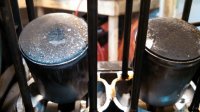Terry Syd,
I'm not sure if you understand that on the metering diaphragm that pushes the inlet lever controlled by the spring one half (fuel side) has a negative pressure from the air drawn through the carburetor, the other side with ambient pressure (the air all around us) gives the diaphragm a push thus overcoming the spring pressure letting more fuel back in, and starts all over again. So there is positive, negative and ambient pressures all coming into play to make everything work properly. Put too heavy a spring into the mix and these pressures will not be able to fully overcome the springs pressure causing a lean condition, too light a spring it will be rich.
I'll give an example, a Tillotson HR carburetor was rebuilt from an aftermarket kit with a replacement metering spring. As the picture shows with not so good results. After the engine had a complete rebuild, and a little more closer attention was payed after fire up, it was running hot and lean and was shut down. With some bit of detective work it was finally ascertained that the "pop off" pressure(the amount of pressure it takes to push off the needle valve from its seat with a pressure testing tool) of the replacement spring was at 35 PSI, proper replacements were obtained from Tillotson in Ireland, those springs, some other old ones I was able to conjure up and one sent to me from the aftermarket manufacturer tested at 11 PSI. This was installed and ran fine the engine tuned in properly and ran cool, and continued to run properly for two seasons now. So there was no doubt as to the cause of the lean out.
So that being said, it would seam reasonable that a built engine that is now fuel starved should have a bit lighter spring installed allowing all of those pressures to overcome it more easily letting more fuel in that the built engine requires. Heck, just having the inlet lever a little high or low will make an engine rich/lean. Or putting the gasket on the wrong side of the diaphragm will cause the engine not to run at all. I'm sure a few of us can attest to that myself included.
As far as Mikuni carburetors go I'm only familiar with their slide carburetors.
Not sure that I'm the best at explaining things especially while typing. Hope this is a little clearer for every one. If I botched a part let me know, I'm getting tired now.
I've also included some reading from Tillotson and Zama to look at as well, tried one from Walbro but it was too large.
Picture of 294 Rotax engine failure from lean out.







